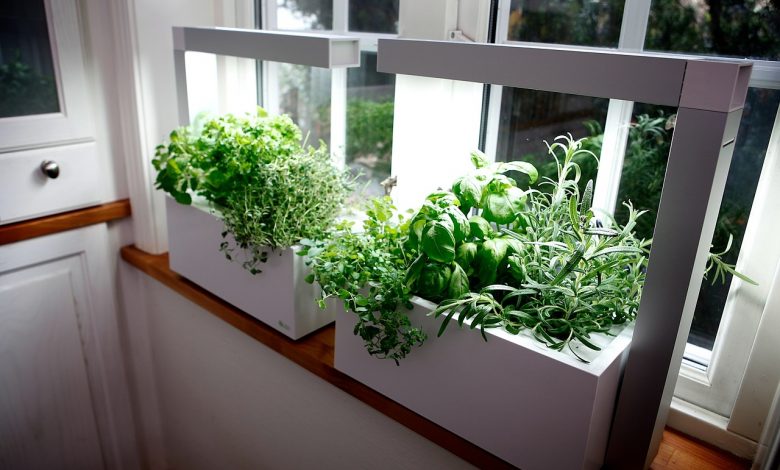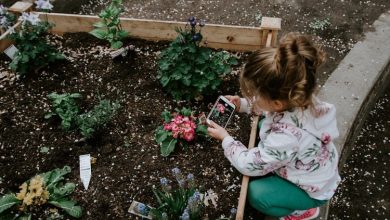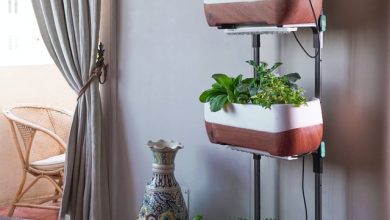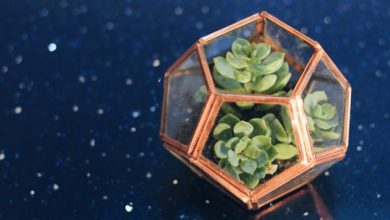Indoor Hydroponics: A Trendy New Approach To Gardening

Indoor hydroponics has become the new gardening craze lately because of its versatile and cost-effective nature. If you live somewhere you don’t have warm sunny weather all year round and you want to keep gardening through the harsh winters, indoor hydroponics is a great option.
But it’s really the versatility of this so-called ‘soilless gardening’ method that makes it such a draw. You can do it with high-or low-tech equipment, and you can really dive in and make it complex or keep it simple. And you can do it both indoors and outdoors – its super versatile! It’s sort of like the traveling garden – wherever you go, you can bring a hydroponic garden with you.
The best part is that you grow them in a diverse range of settings, from a dark basement corner to big commercial warehouses, or even outside on an apartment balcony. Not only can a hydroponic garden grow anywhere, but you can also grow almost anything you please. From greens and herbs, to tomatoes and cucumbers, even root vegetables and flowering plants of all shapes and sizes are an option.
But before we get into the pros and cons of indoor hydroponics, let’s figure out exactly what they are!

What Is An Indoor Hydroponic System?
An indoor hydroponics system is an intensive method of plant-growing that allows for big and year-round harvests in just about any climate as long as you’ve got enough space in your place for it.
No need to worry about getting the inside of your house dirty with hydroponics, as this method feeds the plants their nutrients through water-based solutions using no soil whatsoever. This makes it possible to grow a luscious garden indoors without the mess. You’re growing plants without even planting them in the ground! How awesome is that?
It’s a hyper-sustainable gardening method that constantly provides optimal growing conditions and oxygen levels for your plants, allowing them to thrive, so long as they’re fed the proper nutrients and have enough light. Many modern indoor hydroponic gardening systems use pumps to deliver the nutrients your plants need, from the bottom reservoir, up through a drip ring where it gets spread through the growth chamber to all plants that need it, before draining back into the reservoir.
And you don’t even need to worry about over or under-watering your little seedlings either. The hydroponic system keeps them satisfied with as much or as little H2O as they need at any given time.
While hydroponics is a great and healthy indoor growth method for your plants, it also requires quite a bit of consistent work and attention to make it all worthwhile. Growing plants in soil offers something of a safety net in terms of moisture and nutrients, whereas growing them using this method puts the onus on you. Any missed flooding or miscalculations in nutrient measurement and application could put your indoor garden in dire straits.
But thanks to technology and commercial nutrient solutions – a lot of the guesswork has been eliminated, and a good, capable system can make growing an efficient indoor garden easy even for total beginners.
These days you’ll even be able to find fully equipped hydroponic gardening kits that make it easy for gardeners to get all the materials and instructions to get started in one centralized place.

A Brief History of Hydroponics
The earliest example of hydroponic-type plant-growing methods goes back at least as far as human history does. The legendary Hanging Gardens of Babylon and the serene Floating Gardens of China were just a couple of examples of these techniques being used thousands of years ago.
The general theory behind hydroponics has stayed consistent, but modern technology has turned hydroponic gardening into something the Babylonians and Chinese of old couldn’t have even imagined, as we can now grow healthier and stronger plants at a much faster rate.
The first “modern” mention of hydroponics came in the 1920s. This is when the man who coined the term, plant scientist Dr. William F. Gericke, started combining the Greek root ‘hydro,’ which refers to something of liquid nature, with ‘ponic’ which suggests work and/or action.
He wrote a classic text on hydroponic gardening in the year 1940, which is still read to this day, called The Complete Guide to Soilless Gardening. In this work, he laid out the groundwork for all the high-tech hydroponic systems we have available to us in modern times. While he was, of course, ridiculed at first, Gericke, who was working at the University of California, Berkeley at the time, got the last laugh when he grew a 25 foot high tomato vine with his hydroponic method.
This obviously intrigued the world of science, and it wasn’t long before tons of research was being done on the matter by scientists at the University of California, who uncovered a treasure trove of benefits associated with the revolutionary method. The military soon caught wind of these benefits and began distributing hydroponically grown vegetables during the Pacific Theater during World War II, and then at American hospitals during the Korean War. And the method is still widely used in today’s military, with it most recently being used to feed American soldiers during both invasions of Iraq.
Many of the advancements we’ve seen in hydroponic growing over the years have come from scientists in labs. But more recently, it has been an eclectic group of green thumb individuals looking for more efficiency, higher yields, and increased ease of operation that have been making the most progress. The most simple and practical systems you see nowadays combine tried-and-true practices with modern equipment adapted to each grower’s unique needs.

What Are The Benefits And Downsides Of Indoor Hydroponics?
Now that we know a bit about what hydroponics is and how it got started, let’s discuss the benefits of starting your own indoor hydroponic garden!
Some of these benefits are far more apparent than others. Still, there are no two ways about it: the advantages of indoor hydroponic plant-growing are plentiful and varied.
One of the best things about having your own personal indoor hydroponic garden comes into play during the cold winter days when you look at your salad bowl and see that it’s chock full of fresh and vibrant greens, herbs, and vegetables that you grew yourself right in your basement, laundry room, or garage.
It’s awesome to be able to stroll down to your basement and pick out fresh herbs and vegetables in the dead of winter, but it’s also just nice to be gardening at all. The winter months will no longer be a time when you can’t do much but wait, plan, and leaf through your favorite seed catalogs.
Even novice indoor gardeners with small systems can plant and harvest during even the chilliest February evening. Not only are you saving money on groceries and eating healthy thanks to all those tasty veggies in your garden. But you’re also getting that elusive sense of completion and accomplishment that everyone who’s successfully cooked a challenging meal from scratch can attest to.
You’ll Conserve Water
One of the biggest pros of hydroponic gardens is their capacity for water conservation. Hydroponic systems have been known to use as much as 95 percent less water than regular, soil-based methods.
Since we’re talking about an indoor garden, the system isn’t exposed to sunlight and other outside sources, which drastically reduces evaporation. Plant-growing in soil also sometimes requires very exact amounts of water, with too much suffocating some plants, and too little drying others right out.
Hydroponics combats this issue in three ways:
- First, the water reservoir is constantly oxygenated, which means your plant’s roots are getting the perfect oxygen-level they need to thrive.
- Second, because the water is recirculated by the hydroponic system, this method uses a lot less water than soil farming does. The plant rarely uses most of the water, and hydroponics allows the unused H2O to filter back into the reservoir where it can be reused next time your plants get thirsty. In especially dry or arid climates, this particular benefit is doubly important.
- The third way is that you, as the gardener, have total control over the growing environment, which actually has a lot more benefits than just the ability to regulate your water, such as
- When pests or diseases occur (which they almost never do), they’re much easier to identify and subsequently deal with.
- It’s hard for pests and bugs to even reach your plants because they’re usually in a raised bin and far out of reach.
- Weeds are a problem of the past because of the controlled environment provided by hydroponics.
- Soil-related diseases that can be so frustrating with natural, outdoor gardening are a complete non-factor thanks to the hydroponic system.
- Since your plants are grown inside, they’re not subject to the whims of the weather outside, which are not always ideal for every plant.
- The hydroponic system is also great at regulating light exposure for your plants instead of having to strategically place plants in sunny or shady locations in other gardening systems.
- You’re able to precisely provide your plants with their nutrients, which ultimately saves you money on plant nutrition costs.
Your Plants Will Grow Bigger And Faster
Many experts agree that a plant growing in a hydroponic system can outgrow the same plant in a traditional soil plot by as much as 30 percent.
The reason for this is that the plants spend zero time and energy, continually searching for the nutrients they need to grow. Instead, your indoor garden system brings the plants exactly what they need, when they need it, leaving them lots of extra energy that they put towards growth.
The efficiency saves you time, and you’ll see your veggies yielding harvestable results much more often than your outdoor gardens can. And not only are the plants yielding harvests more often, but the harvests are more plentiful too. Though scientists are less certain on why this is the case, it’s a fact that hydroponic systems have been shown to bring 20 – 25 percent higher yields when compared with plant-growth in traditional soil.

It’s Far More Versatile
Another great thing about the indoor hydroponic gardening system is how versatile it is. Whether you buy a pricey system or make a DIY model yourself, this gardening system will get the job done. Another great asset is the fact that it can be portable, which means you can take it with you if you ever move.
The no-soil growing method is also an important aspect when it comes to the versatility of hydroponics. Not everyone has the luxury of living in an area where there is readily available, rich, and nutritious soil to grow your plants in. Even if you live in a city or town that enjoys a warm climate, you’ll still be hard-pressed to find good soil. Sometimes the soil near you just isn’t conducive to plant growth, the climate won’t allow an outdoor garden, or there simply isn’t enough space because you live in a busy, crowded, urban area. In all of those situations, a well-thought-out indoor hydroponics garden could thrive easily with the right amount of care and attention.
The varying sizes of indoor hydroponics gardens are a great feature as well. You can move your garden wherever you please, and it’s also much more compact than a sprawling outdoor garden. Hydroponics also allows for a lot more plants to be grown near one another since their roots don’t have to spread deep into any soil to find the nutrients they crave. Instead, they’re being fed by oxygenated nutrient-rich water solution. It’s the perfect solution for anyone with a green thumb and a taste for fresh veggies living in a tight spot or a small urban space.
But as with most things, hydroponics isn’t all sunshine and rainbows. Let’s take a look at some of the cons that come with this method.
It’s Eco Friendly And Sustainable
Thanks to the popularity of this rapidly growing industry, we’re now seeing even big commercial companies turn to hydroponics as a sustainable solution. Over the last decade, this led to millions of enormous hydroponic greenhouses appearing all over the world. And that world is one that is fighting tragic issues on so many fronts, one of the most important of which is a lack of fresh water and food that is caused largely by a combination of human overconsumption and waste.
Hydroponics is helping gardeners conserve unbelievable amounts of water (up to 90 percent according to the experts) that would otherwise be wasted and overlooked in a soil garden. To put that into perspective, while a pound of lettuce grown in a traditional soil plot usually takes 71 gallons of water to grow, that same lettuce growing in a hydroponic environment needs just three gallons. Isn’t that shocking?
The sustainability of the whole proposition is a huge upside to making the switch. You’re reducing your need for grocery shopping and reducing your carbon footprint by eating in the most sustainable way possible: your own little garden in the darkest corner of your basement. You’re not relying on any big corporations, that might cut corners in order to increase production, for your food – instead, you’re growing it all by yourself! Not to mention you don’t have to limit yourself to fresh produce for just a few months a year; you can have a fresh cucumber or tomato whenever your heart desires.
You’re also using less land, which means less land erosion that typically takes place with farming. And it should also be mentioned that hydroponics drastically reduces the need for nasty pesticides and fertilizers. Tending more to indoor gardens that don’t suffer from pest problems is a total boon to the environment, as it reduces our need to produce and actively make use of pesticides that can easily damage that same environment.
Oh, and there’s also no need to fertilize the soil ether. Why? Because there is no soil! This means that the need for artificial and chemical fertilizers is practically nonexistent.
The Few Cons of Hydroponic Gardens
While there are a lot more pros than cons with indoor hydroponic gardening, there are still a few cons nonetheless. One of the more pronounced ones is that top-end hydroponic systems can sometimes cost several hundred dollars alone, and that’s before buying your starter kit.
However, that’s barely even a disadvantage because there are countless cheap DIY options for making your own simple hydroponic system that works just as well as store-bought variants. If you want to go big on your hydroponic system, you can, but definitely don’t have to, drop tons of cash to make your indoor gardening dream come true.
The other con is much more important and indeed very real: hydroponics requires constant attention and care. While this method usually works without any hiccups, things happen from time to time, and when they do, they have to be fixed right away. When gardening in soil, a plant can access nutrient stores on their own whenever they need, but hydroponics is an exact science where the system constantly feeds the plants directly.
That means that if something breaks in the system or you forget a hydroponic chore you were supposed to do, it’s not just the end for one of your plants – your whole crop will have been wasted. The same goes for when you get higher levels of humidity and fungi or mildew get introduced into a system. If that happens, the whole group of plants is finished. So unless you’re being careless with your hydroponics, there really is no downside to speak of. Just remember to stay attentive and be diligent in keeping up with the feeding schedule!

So there you have it: indoor hydroponic gardening in a nutshell. We took you through what exactly this new and trendy gardening method is and gave you a bit of the history behind the words and methods.
We also gave you a complete picture of the positives and negatives associated with running an indoor hydroponic system, including how much bigger and faster your garden can grow in a hydroponic environment if it gets the right attention.
But possibly the most important thing we discussed was the hydroponic movement’s positive effects on our struggling environment. With companies continuing to ruin our atmosphere and our environment, a sustainable, eco-friendly alternative to anything is always a welcome sight. Get yourself going with an indoor hydroponic garden, and you’ll have a beautiful (and tasty) green garden in your basement in no time.



